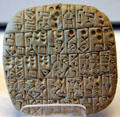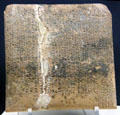 |  |  |  |
| History of writing relief showing Neolithic cave paintings, Egyptian hieroglyphics, cuneiform, & Hebrew carved above portal of Sterling Memorial Library. New Haven, CT. | Collection of ancient cuneiform clay tablets from Mesopotamia at Rosicrucian Egyptian Museum. San Jose, CA. | Cuneiform tablet concerning sale of a field & house (2600 BC) at the Louvre Museum. Paris, France. | Cuneiform tablet with accounting of offerings made to divinities at temple of Lagash (2370 BC) at the Louvre Museum. Paris, France. |
 |  |  |  |
| Ancient cuneiform clay tablet from Mesopotamia at Rosicrucian Egyptian Museum. San Jose, CA. | Cuneiform clay tablet calculating new moon for years 118-119 (written on Jan. 7, 194 BCE) from Uruk (Iraq) at Pergamon Museum. Berlin, Germany. | Cuneiform manuscript describing ritual (626-539 BCE) from Iraq at Chester Beatty Library. Dublin, Ireland. | Cuneiform inscription wall by King Nebuchadnezzar II (604-562 BCE) describing why he built Ishtar Gate & processional way at Pergamon Museum. Berlin, Germany. |
 |  |  |  |
| Details of cuneiform inscription by King Nebuchadnezzar II (604-562 BCE) using reassembled brick shards from near Ishtar Gate at Pergamon Museum. Berlin, Germany. | Assyrian two winged genie (c870 BCE) from Nimrud NW Palace of Kings at Museum Ägyptischer Kunst. Munich, Germany. | Cuneiform detail of Assyrian two winged genie (c870 BCE) from Nimrud NW Palace of Kings at Museum Ägyptischer Kunst. Munich, Germany. | Iran: alabaster reliefs details of cuneiform writing from palace of Assyrian king Ashurnasirpal II (883-858 BCE) at LACMA. Los Angeles, CA. |
 |
|
|
|
| Detail of cuneiform on Alabaster Assyrian relief (883-859 B.C.) from Nimrud Palace in Yale Art Gallery. New Haven, CT. |
|
|
|








